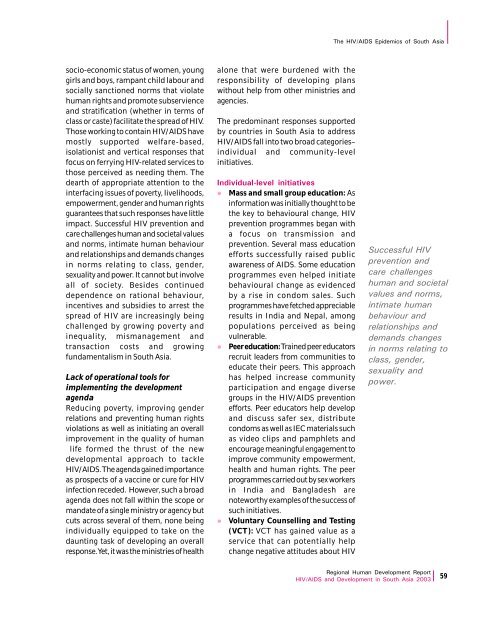Download Report - UNDP Asia-Pacific Regional Centre - United ...
Download Report - UNDP Asia-Pacific Regional Centre - United ...
Download Report - UNDP Asia-Pacific Regional Centre - United ...
You also want an ePaper? Increase the reach of your titles
YUMPU automatically turns print PDFs into web optimized ePapers that Google loves.
The HIV/AIDS Epidemics of South <strong>Asia</strong>socio-economic status of women, younggirls and boys, rampant child labour andsocially sanctioned norms that violatehuman rights and promote subservienceand stratification (whether in terms ofclass or caste) facilitate the spread of HIV.Those working to contain HIV/AIDS havemostly supported welfare-based,isolationist and vertical responses thatfocus on ferrying HIV-related services tothose perceived as needing them. Thedearth of appropriate attention to theinterfacing issues of poverty, livelihoods,empowerment, gender and human rightsguarantees that such responses have littleimpact. Successful HIV prevention andcare challenges human and societal valuesand norms, intimate human behaviourand relationships and demands changesin norms relating to class, gender,sexuality and power. It cannot but involveall of society. Besides continueddependence on rational behaviour,incentives and subsidies to arrest thespread of HIV are increasingly beingchallenged by growing poverty andinequality, mismanagement andtransaction costs and growingfundamentalism in South <strong>Asia</strong>.Lack of operational tools forimplementing the developmentagendaReducing poverty, improving genderrelations and preventing human rightsviolations as well as initiating an overallimprovement in the quality of humanlife formed the thrust of the newdevelopmental approach to tackleHIV/AIDS. The agenda gained importanceas prospects of a vaccine or cure for HIVinfection receded. However, such a broadagenda does not fall within the scope ormandate of a single ministry or agency butcuts across several of them, none beingindividually equipped to take on thedaunting task of developing an overallresponse. Yet, it was the ministries of healthalone that were burdened with theresponsibility of developing planswithout help from other ministries andagencies.The predominant responses supportedby countries in South <strong>Asia</strong> to addressHIV/AIDS fall into two broad categories–individual and community-levelinitiatives.Individual-level initiativesl Mass and small group education: Asinformation was initially thought to bethe key to behavioural change, HIVprevention programmes began witha focus on transmission andprevention. Several mass educationefforts successfully raised publicawareness of AIDS. Some educationprogrammes even helped initiatebehavioural change as evidencedby a rise in condom sales. Suchprogrammes have fetched appreciableresults in India and Nepal, amongpopulations perceived as beingvulnerable.l Peer education: Trained peer educatorsrecruit leaders from communities toeducate their peers. This approachhas helped increase communityparticipation and engage diversegroups in the HIV/AIDS preventionefforts. Peer educators help developand discuss safer sex, distributecondoms as well as IEC materials suchas video clips and pamphlets andencourage meaningful engagement toimprove community empowerment,health and human rights. The peerprogrammes carried out by sex workersin India and Bangladesh arenoteworthy examples of the success ofsuch initiatives.l Voluntary Counselling and Testing(VCT): VCT has gained value as aservice that can potentially helpchange negative attitudes about HIVSuccessful HIVprevention andcare challengeshuman and societalvalues and norms,intimate humanbehaviour andrelationships anddemands changesin norms relating toclass, gender,sexuality andpower.<strong>Regional</strong> Human Development <strong>Report</strong>HIV/AIDS and Development in South <strong>Asia</strong> 2003 59
















